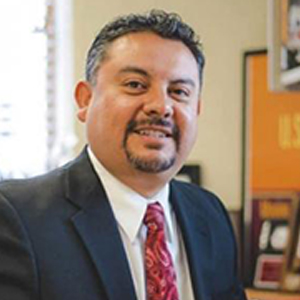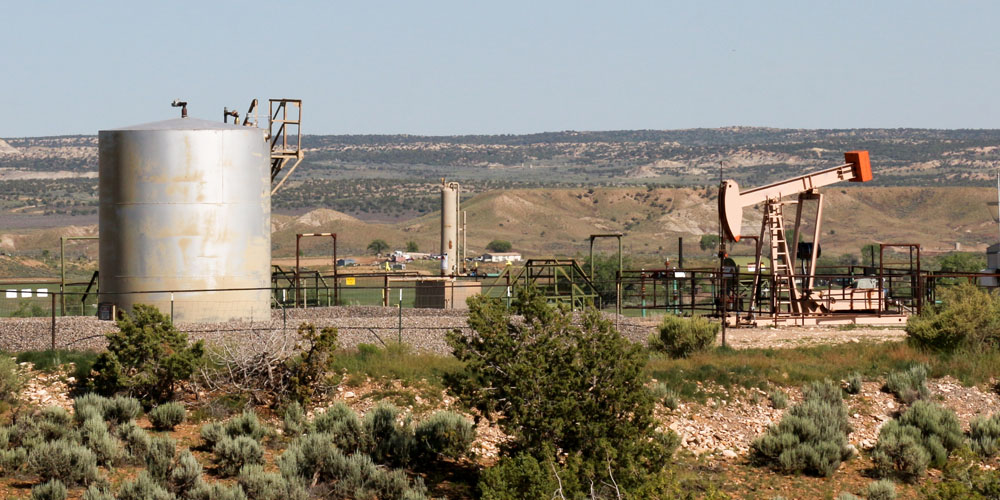The give and take of the economy and those who drive it is a topic that UNM’s Center for Social Policy (CSP) strives to highlight as part of their mission to address social inequalities.
In a new, joint cross-campus research project from CSP Director Gabriel Sanchez and College of Population Health (COPH) Professor and Center for Participatory Research Director Shannon Sanchez-Youngman analyze this battle of concessions in the Southeastern New Mexico Oil & Gas Workforce Study.
Our study had two main goals, to identify paths to improve the working conditions of oil and gas workers, and to help inform areas in workforce training that should be addressed as the state transitions to clean energy production.
“Our study had two main goals, to identify paths to improve the working conditions of oil and gas workers, and to help inform areas in workforce training that should be addressed as the state transitions to clean energy production,” Sanchez said.
The study, commissioned by the nonprofit Somos Un Pueblo Unido, dove into the quality of life experienced by oil and gas workers in the state’s Permian Basin–the majority of which are Hispanic New Mexicans. This incorporated the past and present conditions, and how the influence of clean energy could shift their career plans moving forward.
“Oil and gas production is the driving force for our state's economy and in the Permian basin where our study was conducted, the economic impact on the region is massive,” Sanchez said. “I have learned through the collaboration with Somos that the overall workforce that supports the oil and gas industry are heavily Hispanic New Mexicans. That population is my area of focus in my own academic research so this made me much more interested in the project.”
There are a lot of factors which have to be accounted for when analyzing populations like this. Sanchez and Sanchez-Youngman did multiple waves of focus groups, incorporating anonymity, rewards for participation and diverse responses across the nearly 200 participants, which included oil and gas workers, members of their family, and service providers who provide workforce development training in the region.
I have a large body of work that seeks to develop community and policy level interventions that address these social determinants of health. This work is critical.
“I study how socio-structural factors including policy, labor markets, citizenship status, racism, and working conditions contribute to inequities in health and well-being among marginalized populations,” Sanchez-Youngman said. “Conversely, I have a large body of work that seeks to develop community and policy level interventions that address these social determinants of health. This work is critical.”
Not only this, but many of the workers interviewed in the Permian Basin were migrants, or Spanish-speaking dominant. With the need to build that trust with surveyors, it was especially critical to work with Somos Un Pueblo Unido.
“Working with communities like Latino oil and gas workers is challenging, as many of whom are Spanish dominant and immigrants. We always partner with community organizations who have strong relationships with the communities they work with to help overcome these challenges,” Sanchez said. “Somos un Pueblo Unido is the ideal partner for this project given their built in trust and deep knowledge of the Southeast region of the state.”
This was operating under a bigger scope underway at UNM, as part of the Grand Challenges program. As one of the few selected research areas of focus for the university wide program, this group is focused on a just transition to clean energy. Still, Sanchez and Sanchez-Youngman knew despite intentions to move to a cleaner world, the oil and gas community would be impacted, and should have their say in the change.

“We have done a lot of work collecting the attitudes and experiences of New Mexicans since the policy discussions of the Energy Transition Act began a few years ago, but the gap in our work was speaking directly with oil and gas workers, the community most likely to be impacted by the movement to clean energy production,” Sanchez said. “It has taken us some time to gain the trust of this organization and their partners, but we are in a great place in the relationship which leads to better research.”
So, from late 2023 to now, Sanchez and Sanchez-Youngman engaged in qualitative and quantitative surveys to learn more about the people behind the numbers.
“Through our Grand Challenge work we have been able to weave together a truly cross-disciplinary approach to understanding and solving the complexities related to creating a just transition from oil and fossil fuels to clean energy,” Sanchez-Youngman said. “My expertise on the project is to collaborate closely with organizations and grassroots residents to understand what a just transition entails given the contextual needs of workers across the state.”
What Sanchez and Sanchez-Youngman found was incredibly startling. A massive economic output comes with a massive cost, beginning with internal struggles.

“Workers in this arena suffer from a number of health issues including high rates of injury and death, substance misuse and mental health issues emanating from long term separation from families and the isolated nature of the work,” Sanchez-Youngman said.
Externally, the work which goes on in the Permian Basin is extremely dangerous–not just in terms of weather, materials and hours, but risky equipment and duties.
“There is a high rate of accidents, many of them fatal. The workers we heard from believe that many of these accidents can be avoided with better safety protocols. One of the main factors that workers identified leading to accidents is the high number of work hours they put in each week. This is a great source of income for these workers but it can lead to accidents,” Sanchez said.
That doesn’t entirely stop, either, when the workers end their increasingly long shifts.
“The most obvious example of the dangers workers and everyone else in the region faces is the commute to and from work. The main highways used by commercial vehicles are very dangerous due to big vehicles driving very fast. Many workers noted how dangerous this is for them and their families,” Sanchez said.
This is where the caveat of the economy comes in. Oil and gas makes up about 40% of New Mexico’s revenue, approaching multi-billion dollar totals. These long hours, despite treacherous conditions, add up to a tremendous economic output for the state, but not for the workers themselves.
“Workers really do face dangerous job conditions, long working hours and still little power to negotiate for better working conditions in the private oil industry,” Sanchez-Youngman said.
This study found a salary of $25,000 (often less) awarded to oil and gas workers, without benefits. Those who did live comfortably, still had to put an absurd amount of overtime there to get to that point.
“While we found that many of the workers we interviewed do make great incomes, I did not realize that most of these workers are putting in a ton of overtime to achieve that salary and most do not have access to benefits. As we move toward clean energy production it will be key that the industry puts protocols in place to generate more pay equity across the workforce,” Sanchez said.
Although the environment and region beyond the work zones aren’t terribly forgiving either, many workers actually enjoy the work they do and where they live to do it.
“We learned that the oil and gas workforce in the Permian basin love living in that region of the state and would love to remain there if they are able to get re-trained for other industries,” Sanchez said. “The state will need to invest in the workforce training infrastructure needed to transition these workers to other careers, but we have time to get this done right if we begin the process aggressively now.”
The survey also revealed there is awareness across generations and job types in the oil and gas sector that the clean energy revolution is coming.
“Oil workers and other workers who support the oil based economy want to engage in incentivized training to improve their basic adult education skills and expand their job skills to move into new industries such as solar power, construction, and child care service provision,” Sanchez-Youngman said.
In the Center for Social Policy and UNM Health Sciences, UNM researchers don’t just uncover the problem through painstaking surveying; they also provide recommendations for solutions.
“Conducting this community based research with workers in the Permian Basin has identified structural and workforce conditions within the Permian Basin, and helped begin to co-develop long term solutions that promote safer and more equitable working conditions and higher wages with worker input,” Sanchez-Youngman said.
Overall, this combination of responses has showcased the instability and unreliability of the oil and gas industry long term. Environmental and health factors aside (7 million tons of methane emissions and $77 billion in total health impact in one year), the lifestyle lived by approximately 8.5% of New Mexico workforce in the Permian basin cannot continue long term.
“There is evidence that creating a stronger training infrastructure can improve the ability of workers to obtain safer and higher paying employment and that it is equally important to build more proficient social infrastructure in southeastern New Mexico to support the health and social needs of the population,” Sanchez-Youngman said.
State policy recommendations from the study include more investment in safety nets for workers in emerging industries, funding for adult education programs, and prioritizing safer working conditions. Not only that, but Sanchez and Sanchez-Youngman are emphasizing a diverse range of jobs for non-English speakers in related industries.
This has already had an impact on the latest New Mexico Legislative Session, which just wrapped up in February 2024. In addition to the prominent highlighting of the research, the state legislature passed multiple bills tied to what was revealed. This included $5 million for the state’s Adult Education Division to expand education and skills building programs for adult workers, a $1 million, three-year pilot to provide monthly cash stipends to low-income workers in those adult education programs, $60 million to the Higher Education Department for workforce development programs and tuition assistance and $1.16 million additional funding to the Department of Workforce Solutions specifically to help caseloads in wage disputes.
While the clean energy transition will not be a simple one moving forward, integrating feedback of all involved parties–like this CSP and COPH research–is increasingly vital.
